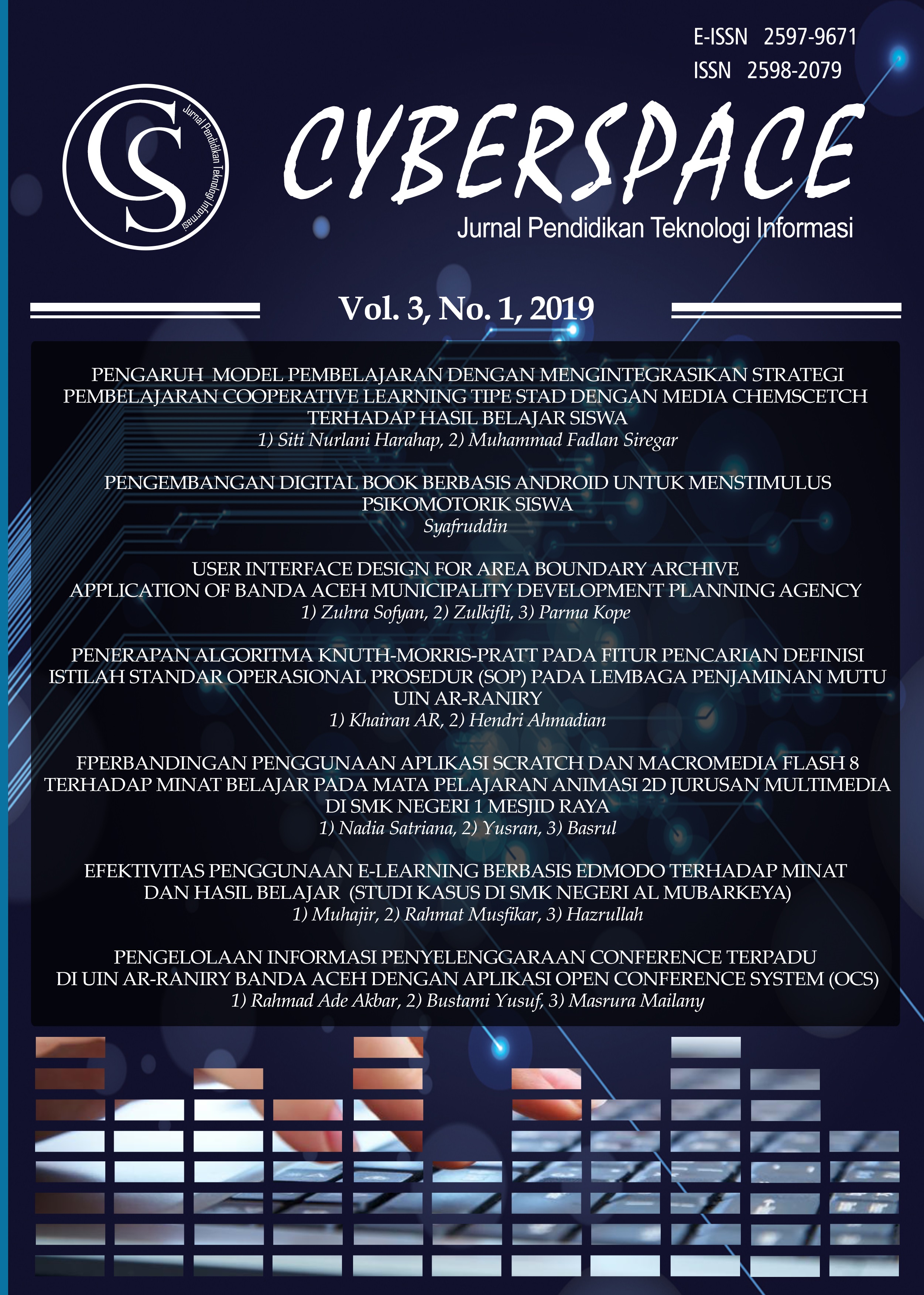PENGEMBANGAN DIGITAL BOOK BERBASIS ANDROID UNTUK MENSTIMULUS PSIKOMOTORIK SISWA
DOI:
https://doi.org/10.22373/cj.v3i1.4212Keywords:
Android-based digital book, students’ psychomotoric, Fiqh lessonAbstract
This study aims to: (1) produce an android-based digital book application to concretize students' motoric understanding on the Fiqh subject matter in waqf (endowment) lesson, and (2) find out the extent of the appropriateness (quality) of the application that have been developed. The research is Research and Development (R & D) using the model of Alessi and Trollip which is adjusted based on the needs of the researcher. The development procedure consists of three stages (a) planning, (b) design, and (c) development which includes standards, ongoing evaluation, and project management. This research resulted in: (1) Android-based digital book application and guidebook for user, and (2) have quality based on a feasibility trial through alpha test and beta test. Alpha test was assessed by two material experts with a mean score of 3.40 (very feasible), and 3.45 by media experts (very feasible). Beta Test is carried out in small group of 6 students with a total score of 3.53 and a very feasible category. The increase occurred when a large group trial of 30 students of MAN 1 Pidie Class X IPA with a total score 3.67 was categorized as very feasible. Based on the feasibility trial, it is possible for an Android-based digital book application to be able to stimulate the psychomotor component of students for the learning of Fiqh subject in waqf (endowment) lesson.
References
Departemen Agama RI.(2004).Kurikulum Madrasah Tsanawiyah (Standar Kompetensi). Jakarta:Departemen Pendidikan Nasional
Pheeraphan, N. (2013). Enhancement of the 21st century skills for thai higher education by integration of ict in classroom. Procedia - Social and Behavioral Sciences, 103, 365-372
Ismail SM. (2008).Strategi Pembelajaran Agama Islam Berbasis PAIKEM, Semarang: Rasail Media Group
Noorhidawati, A., & Gibb, F. (2008). How students use e-books – reading or referring? Malaysian Journal of Library & Information Science, 13(2), 1–14. Retrieved from http://ejum.fsktm.um.edu.my/Articl eInformation.aspx?ArticleID=656
Jones, T., & Brown, C. (2011). Reading engagement: a comparison between ebooks and traditional print Books in an elementary classroom. International Journal of Instruction, 4(2). Retrieved from http://www.eiji.net/dosyalar/iji_2011_2_1.pdf
Surjono, H. D. (2014). Peran teknologi pembelajaran dalam pengembangan & peningkatan mutu SDM di era global. In Seminar Nasional Teknologi Pembelajaran, di Universitas Negeri Yogyakarta.
James Ohene-Djan, Personalising Electronic Books, (Journal of Digital Information, Vol 3, No 4, 2003)
Butcher, C., Davies, C., & Highton, M, (2006) Designing learning: from module outline to effective teaching. New York: Routledge
Departemen Agama RI.(2004).Kurikulum Madrasah Tsanawiyah (Standar Kompetensi). Jakarta:Departemen Pendidikan Nasional
Alessi, S.M., & Trollip. (2001). Multimedia for learning: Methods and development (3th ed.) Massachussets: Ally & Bacon A Pearson Education Company
Mardapi, Jemari, Teknik penyusunan instrument tes dan nontes. (Mitra Cendikia Press: Yogyakarta, 2008)
Downloads
Published
Issue
Section
License
Authors who publish with Cyberspace Journal agree to the following terms:
- Authors retain copyright and grant the journal right of first publication with the work simultaneously licensed under a Creative Commons Attribution License that allows others to share the work with an acknowledgement of the work's authorship and initial publication in this journal.
- Authors are able to enter into separate, additional contractual arrangements for the non-exclusive distribution of the journal's published version of the work (e.g., post it to an institutional repository or publish it in a book), with an acknowledgement of its initial publication in this journal.
- Authors are permitted and encouraged to post their work online (e.g., in institutional repositories or on their website) prior to and during the submission process, as it can lead to productive exchanges, as well as earlier and greater citation of published work (See The Effect of Open Access).



















